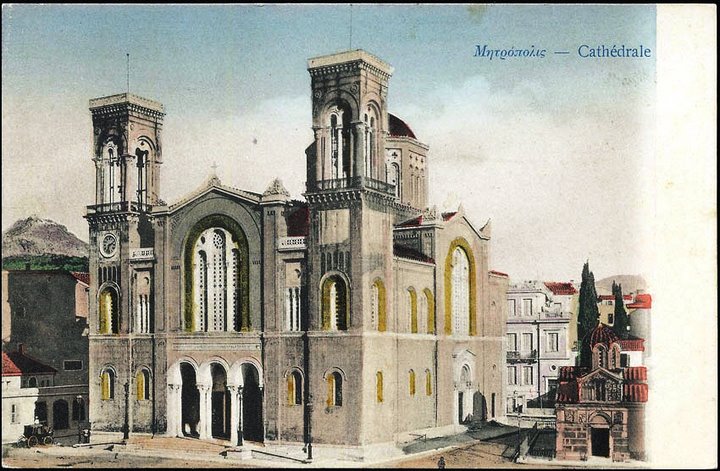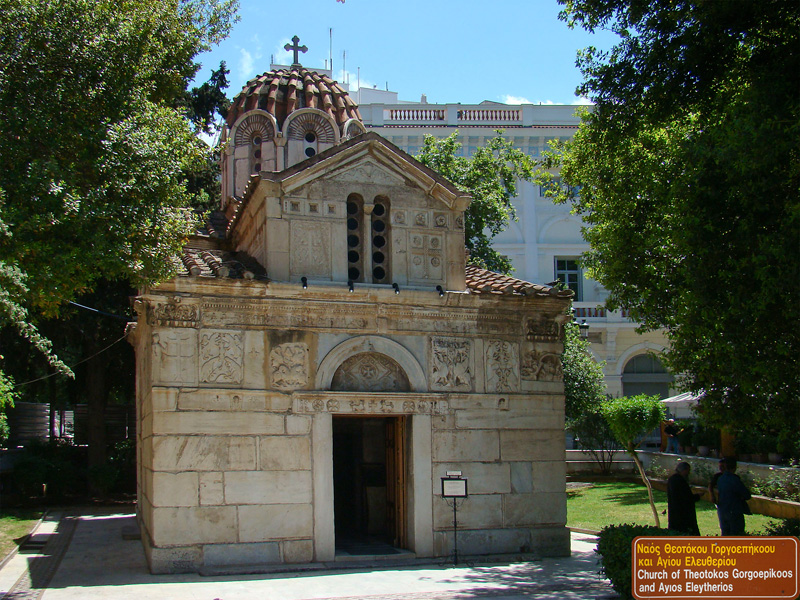
 History of Mitrópoli (Cathedral)
History of Mitrópoli (Cathedral)
When Athens became the capital of Greece in 1834, a cathedral was needed here. Construction on the Mitrópoli began on Christmas Day in 1842 with the laying of the cornerstone by King Otto and Queen Amalia. Workers used marble from no less than 72 demolished churches to build the Mitrópoli's immense walls.
Three architects and 20 years later, it was complete. The king and queen were present at the dedication on May 21, 1862 in honor of the Evangelismós Theotókou (Annunciation of the Virgin).
The Mitrópoli is the seat of the Bishop of Athens and an important spiritual centre of Greek Orthodoxy. It remains a major city landmark and the site of official ceremonies like coronations and important weddings and funerals.
What to See at Mitrópoli (Cathedral)
The Mitropoli has three aisles, a dome over the crossing, and twin west towers; it measures 130 feet long, 65 feet wide, and 80 feet high. Its 19th-century architecture is not generally admired, especially in comparison to the charming Mikri Mitropoli next door.
Inside are colourful Byzantine-style frescoes, gleaming treasures, and the tombs of two saints killed by Ottoman Turks: Agía Filothéi and Patriarch Gregory V.
Agía Filothéi died in 1589; her bones are visible in a silver reliquary. She is honoured for ransoming Greek women who had been enslaved in Turkish harems. Gregory V, Patriarch of Constantinople, was hanged and thrown into the Bosphorus in 1821. His body was rescued by Greek sailors and eventually returned to Athens.
The Panagia Gorgoepíkoös ("Our Lady Who Swiftly Hears"), also known as Agios Eleftherios, is a small 12th-century church in Pláka, central Athens, Greece. It is affectionately known as the Mikrí Mitropolí (Little Cathedral), since the little church is so dwarfed by the neighbouring Mitrópoli.
History of Mikrí Mitropolí
The church was built in the 12th century over the ruins of a temple dedicated to the goddess Eileithyia, patron of childbirth. At the time, Athens was only a small town and a church as small as this was sufficient to serve the local neighbourhood.
What to See at Mikrí Mitropolí
The Little Cathedral measures only 25 feet long by 40 feet wide. The domed cruciform church was built entirely from white Pentelic marble, which has weathered to a warm and creamy hue.
Decorated with friezes and bas-reliefs taken from earlier buildings, the exterior of the Panagia Gorgoepíkoös mixes Romanesque and Byzantine styles. The frieze over the main entrance, depicting the months of the year, dates from the 4th century BC. A Greek cross was added to the centre in the 12th century when the church was built.
The small interior features a checkerboard floor about a foot lower than current ground level, four supporting brick pillars (which replaced the original marble ones in 1834), and an iconostasis.
The cache
The cache is a cylinder box and contains the geocaching declaration sheet and the logbook. No pen inside.
ATTENTION .... the life of the cache depends on your discretion !!!

 Καθεδρικός Ναός Αθηνών
Καθεδρικός Ναός Αθηνών
Ο Ορθόδοξος Καθεδρικός Ναός της Αθήνας, που είναι αφιερωμένος στον Ευαγγελισμό της Θεοτόκου, βρίσκεται στην Πλατεία Μητροπόλεως επί της ομώνυμης οδού. Η κατασκευή του ξεκίνησε το 1842 και ολοκληρώθηκε το 1862. Ο τύπος του ναού είναι σταυροειδής τρίκλιτη βασιλική με τρούλο.
Το κόστος κατασκευής υπερέβη τον προϋπολογισμό. Η διαφορά καλύφθηκε μερικώς από την πώληση εκκλησιαστικής περιουσίας και από δωρεές, κυρίως του βασιλιά Όθωνα και του ευεργέτη Σίνα που ζούσε στη Βιέννη (Αυστρία).
Σύμφωνα με τον αρχικό σχεδιασμό, ο Μητροπολιτικός Ναός των Αθηνών επρόκειτο να ανεγερθεί στην οδό Πανεπιστημίου, δίπλα στη (μελλοντική) Ακαδημία και με βάση αυτό το δεδομένο, ο Δανός αρχιτέκτονας Theophil Hansen (1813-1891) είχε σχεδιάσει (το 1842) μια σύνθεση ρωμανογοτθικής έμπνευσης, αναμεμιγμένης με αναγεννησιακά και βυζαντινά στοιχεία. Η περιοχή εκείνη απορρίφθηκε όμως από τον Δήμο Αθηναίων, κριθείσα “απόκεντρος και ερημική”, και τελικώς αποφασίστηκε ο ναός να ανεγερθεί στην παλαιά πόλη, στη θέση του συγκροτήματος των μητροπολιτικών κτιρίων της Τουρκοκρατίας, τα οποία κατεδαφίστηκαν, με μόνη εξαίρεση τη βυζαντινή εκκλησία της Γοργοεπηκόου. Ο θεμέλιος λίθος τέθηκε τα Χριστούγεννα του 1842, αλλά η οικοδομή (στην οποία χρησιμοποιήθηκαν υλικά 72 συνολικά κατεδαφισμένων Αθηναϊκών ναών) διακόπηκε την άνοιξη του 1843, ελλείψει πόρων.
Ο ναός αποπερατώθηκε το 1862 και το αποτέλεσμα των αλλεπάλληλων αναθεωρήσεων υπήρξε ένα μίγμα νεοκλασικισμού και βυζαντινισμού, χωρίς αρχιτεκτονική συνέπεια, "άτονο και άνευ χαρακτήρος", που υπογραμμίζεται από την αναπόφευκτη αντιπαράθεση με τον παρακείμενο ναό της Γοργοεπηκόου (σημερινού Αγίου Ελευθερίου).
Ο ναός βρίσκεται δίπλα στη Μητρόπολη των Αθηνών και είναι αφιερωμένος στην Παναγία Γοργοεπήκοο και τον Άγιο Ελευθέριο. Βυζαντινός ναός, ο οποίος κατασκευάστηκε στο τέλος του 12ου αιώνα στα ερείπια ενός αρχαίου ναού, που ήταν αφιερωμένος στη Θεά του τοκετού Ειλειθυία και είναι γνωστός ως «Μικρή Μητρόπολη».
Κτίστηκε από τον Μητροπολίτη Αθηνών Μιχαήλ Χωνιάτη στις αρχές του 13ου αιώνα. Σύμφωνα με άλλους ιστορικούς η κτίση της ανάγεται στον 12ο, 11ο ή και 8ο αιώνα.
Το κτίριο είναι κομψό διαστάσεων 12,20 x 7,60 μέτρα. Η αρχιτεκτονική του είναι βυζαντινού ρυθμού της Αρμενίας. Πολλά από τα υλικά του κτιρίου είναι από την κλασική αρχαιότητα, ενώ οι κατασκευαστές της τα επεξεργάστηκαν προσθέτοντας καινούργια διακοσμητικά στοιχεία για να ταιριάζουν στην νεότερη αρχιτεκτονική της εποχής τους. Οι γλυπτές αναπαραστάσεις συνδυάζουν χριστιανικά και παγανιστικά στοιχεία με αρχαία ελληνική διακόσμηση. Μεταξύ των άλλων βλέπουμε μια ζωφόρο αρχαίων εορταστικών εκδηλώσεων.
Η κρύπτη
Η κρύπτη είναι ένα κυλινδρικό κουτί, και περιέχει το logbook και την δήλωση για το geocaching. Δεν έχει στυλό.
ΠΡΟΣΟΧΗ ... η ζωή της κρύπτης εξαρτάται από την διακριτικότητά σας !!!
The FTF goes to : nikos651 